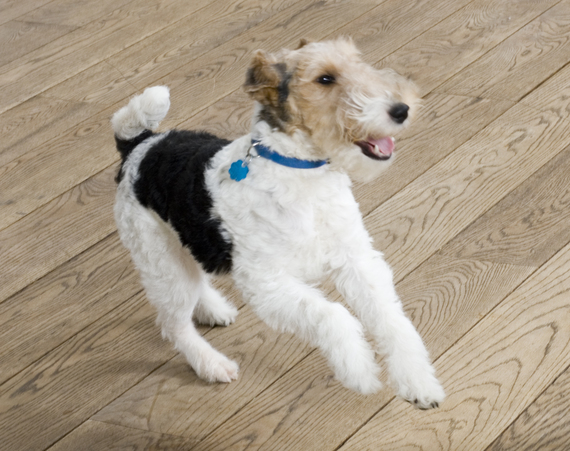Okay. I'll admit it. I gave my new puppy a serious case of the runs. I knew he'd get them, but I did it anyway. It was a gamble that paid off for the both of us.
Before I tell you why and reveal 5 more inspiring things you can do for your new pet, I want you to meet my new dog, Gadzooks--Zookie for short. Zookie is an 8-month-old Golden Retriever recently flown in from Beijing, China.
I didn't go looking for Zookie. Zookie found me. A client had adopted him off Craig's List and decided that he just couldn't keep him.
I wasn't planning on keeping him either. Really. "The Plan" was that I'd foster him, get him housebroken and adopt him out.
Famous last words.
Enter my children, the ones who get attached to snails at the beach.
"Seriously Mom, we have to keep him."
My response was so middle-aged: "He is pretty, but dogs who aren't properly socialized as puppies may never be comfortable in an active household."
"But Mom," my daughter argued, "aren't you like the Dog Whisperer? If you can't help him, who can?"
She had a point. I agreed with one hitch: the kids had to help me. Together we'd try to reform this sound-reactive, boot-destroying, leash-aggressive, midnight-spooking dog so he could learn to trust life again.
I ditched dry kibbles for can food and other canine delicacies. My kids marched around tapping pots and ringing door bells. We drove into the village, doling out more tidbits while cars sped by. I brought him to my group training classes where he met friendly dogs and puppies. In the meantime, he got a wicked case of the runs.
The question is, did our efforts make any difference?
Yes. Zookie is what I call a Textbook Case. His fear of the unknown melted like ice in the summer sun. It didn't take months, it took two weeks.
Arguably, there are better things you can do for a new pet than wreak havoc on his intestinal track. As promised, here are my top 5 suggestions:
1. Observe and Score
Dogs are as different as kids and snowflakes. While you can more easily stereotype a pure-bred, every dog has his own unique character. As a trainer, I love helping my clients discover their new dog's personality.
I categorize five urges. Explore and discover the one motivating your dog. While it can take 2-6 weeks for a new dog to settle in, patterns emerge from the start.
Survival - Food and comfort are primary concerns. If your dog prefers to stay in or comes in quickly after bathroom, returns to resting spots and looks forward to each new meal, then survival is king.
Social --These dogs love to be with others. Often called Velcro dogs, they thrive on togetherness. While Come is a given, they're more prone to separation distress. Self-soothing distractions are necessary when you can't be together.
Freedom - Many dogs prize freedom above everything else. Explorations, new adventures - this dog is up for it all, and he doesn't need anyone to accompany him. Come? Maybe later.
Fun-Dogs who love to play, wrestle and tease are both a lot of work and a lot of fun. Don't let your frustration get in the way! This personality type is not going to enjoy Sit & Stay. Try fetch or chasing games, and play often.
Assertiveness-This dog likes the regime of lessons and learning. Don't have time? Don't be surprised if your dog starts training you. Assertive dogs need direction.
What excites your dog? It may change as he matures and/or feels more comfortable in your home.
2. Feed and Condition
Whether you're investing in a pure-bred or rescuing, feed your new dog by hand for the first couple of weeks. If you're rushed, pocket a portion of food or use a few handfuls to teach your dog the meaning of important words like his name, Watch/Look, Sit and Come.
3. Play/Laugh
Want to bond with your dog? Play with him. Find out what he likes--chasing a toy, following a scent, chewing a stick--and do it with him. Zookie didn't relate to toys immediately, but he loved food, so I'd shake a cup of treats to get his attention. My kids used treat cups to call him back and forth. Then they played hide-and-seek. After watching our other dogs play fetch, Zookie grew curious. Rather than demand obedience, however, we played the two ball toss.
4. Explore/Socialize
Early puppyhood is the ideal time to condition a dog to new sights, smells and people. Before 6 months, a dog is more open to exploring the unknown. After that age, dogs grow more wary and reactive. If you're rescuing an older dog, discover if he's comfortable with unfamiliar sounds and places. Bring an extra stash of goodies, and progress from quiet fields and side streets into more populated areas. I used a can of dog food to distract Zookie when he was frightened. Now he looks to me when he hears unfamiliar sounds.
Get professional help if you need it. The first few outings will shape the rest of your lives together.
5. Self-Soothing
Remember, dogs need more sleep than people. Learning to tolerate alone time is as important as the time you share. The best self-soothing toys for dogs include satisfying bones, stuffed Kongs, and busy toys that inspire their curiosity. To help acclimate your dog to your household, leave on background noise when you leave to lessen the obvious--that they're home alone.
Those are my top five ways to bond with your new pet. Have you got something to add? Please do in the comment section below.
Just promise though: if a dog finds its path to your door, give him every reassurance the world is a happy, loving place. Even if it costs you a few good rugs!
